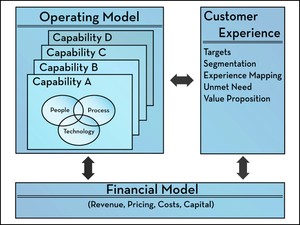How to Innovate Business Models
Should You Create a Business Model Innovation Factory?
What’s the best way to innovate within a company or an industry? According to Saul Kaplan, author of The Business Model Innovation Factory, you should set up an innovation group that is specifically chartered to come up with new business models and to test these in the real world. Kaplan recommends that your Business Innovation Factory be loosely-coupled to the business it’s designed to replace/supplant, but cannot report into it. Lure a business model designer with a lot of experience in design thinking, and systems-level thinking. Recruit innovators from within and outside your industry, rub elbows with “unusual suspects.” Most of all, recruit innovative customers to help co-design new business models.
NETTING IT OUT
Saul Kaplan’s new book, The Business Model Innovation Factory, demystifies several intractable issues that confront people who try to innovate within an existing business. I’ve already sent copies out to several clients, with the note, “Read this! You’ll understand what’s going on!”
Why is innovation so hard to do within a company? Because it’s almost impossible to challenge the existing business model. We all know the truisms about creating a “safe space” to incubate innovation teams, providing them with air cover, giving them license to challenge the status quo and time to experiment, and having them report directly to the CEO. But Kaplan takes this prescription to the next level. He describes how to create and staff a group designed specifically to create new business models that will threaten the status quo. Saul’s Business Model Innovation Factory is more than a design lab. The “factory” includes customers who co-create the solution they need to do a specific job for them as well as the pilot region in which you experiment until you get the business model right.
Without taking both these steps, Kaplan claims, you’ll never succeed in doing more than incremental improvements to existing products and services.
By devoting an entire book to business model innovation, Kaplan makes an important contribution to the discipline and practice of innovation.
WHY IS BUSINESS MODEL INNOVATION IMPORTANT?
What Is a Business Model, Anyway?
Most of us have an idea about what a business model is. Before reading Saul’s book, I admit that my own understanding may have been imprecise. I thought a business model was how you make money and/or deliver value, e.g., what products or services you offer, how and what you charge for them, who pays for those products and services, how you reach and deliver value to the end-customers you serve. Saul Kaplan defines a business model this way:
“A business model is a story about how an organization creates, delivers, and captures value.”
~ Saul Kaplan
He isn’t talking only about for profit businesses. Kaplan devotes several chapters of his book to examples of government and not-for-profit business model innovation efforts.
Saul goes on to explain:
“The story of your current business model can be constructed by answering these three questions:”
How does your organization create value?
How does your organization deliver value?
How does your organization capture value?”~ Saul Kaplan, The Business Model Innovation Factory, p. 19
Saul points out that, in most organizations, there’s a lot of confusion around what the business model really is. If you ask 10 people, you’ll get 10 different answers. Therefore, it shouldn’t come as a surprise that many innovation efforts founder when they challenge any of these three aspects of the existing business model. “Oh, we can’t do that, we’re not a software company; we know how to make physical products.” “We can’t let customers self-serve and answer their own questions, then how would we charge for the experts we have in the field?” “We can’t offer that for free, it would kill our cash cow.”
What's In a Business Model?
(Click on image to enlarge.)
© 2012 BIF
Saul Kaplan's depiction of the Elements of a Business Model.
Business Models Are Short-Lived
But business models now churn as fast as digital goods are invented and consumed. In the industrial era, companies in a given industry typically shared similar business models—how they created, delivered, and captured value. But that era is long gone.
“In the twenty-first century business leaders are unlikely to manage a single business model for an entire career. Business leaders are unlikely to hand down their businesses to the next generation of leaders with the same business model they inherited from the generation before. Leaders are either going to learn how to change their business models while pedaling the bicycle of the current one or they are going to be netflixed.”
~ Saul Kaplan, The Business Model Innovation Factory, p. 4
Saul goes on to describe what he means by being “netflixed,”
“netflix; netflixed
verb
to cause disruption or turmoil to an existing business model
to destroy a previously successful business model
to displace the way value is currently created, delivered, and captured
to be disrupted, destroyed or displaced by a new business model”~ Saul Kaplan, The Business Model Innovation Factory, p. 5
He points out that, although Netflix netflixed Blockbuster, even Netflix has been netflixed (by streaming video) and has been fumbling with its business model as a result.
In the digital era, most businesses change their business models every couple of years. Many start-ups change their business models at such a dizzying pace, it’s referred to as “pivoting” – akin to a basketball player who pivots to reverse direction on the court, often several times within a single play. In fact ...
Sign in to download the full article
0 comments
Be the first one to comment.




